— July 17, 2018
Scalable growth is growth that can be scaled and sustained without a negative impact on the quality of your services. Achieving it requires structuring your agency to streamline operations and prioritize scalability.
Of all the challenges you’ll face when running an agency, few are as tough as scaling.
The agency model actively resists scaling. The resource your growth depends on – people – is neither scalable nor fungible. You can’t add 10 designers and expect 10x more designs, at least not in any predictable fashion.
Yet, scalable growth remains the pursuit and purpose of most agencies.
Scalable growth is simply growth that can scale. It is sustainable, scalable, and predictable, without any impact on your creative output.
What can you do to foster scalable growth in a people-centric service business? Are there any processes, systems, and best practices you can adopt to help you scale?
I’ll look at the fundamental problem of scalability and show you how to structure your agency for scalable growth in this guide.

What Does “Scalable Growth” Really Mean?
Is growing the same thing as scaling?
In an HBR article, Ron Carucci gives a definitive answer: don’t confuse growing with scaling.
He writes:
“Growth means adding revenue at the same pace you are adding resources; scaling means adding revenue at a much greater rate than cost.”
The defining feature of growth is its unsustainability. It often comes from sources that can’t be scaled – a one-off campaign, a random hit, a lucky referral. Even when it comes from scalable sources, the growth often collapses under its own weight.
For example, adding more people to serve more clients seems sustainable initially. But as you continue to add more people, you also create more management issues. Productivity decreases and collaboration suffers as your team-size grows. One designer could serve four clients earlier. Now, he can barely serve three.
Thus, the growth that seemed sustainable initially, can’t be scaled.
In fact, one analysis of small firms even found that firm-size is negatively correlated with productivity.
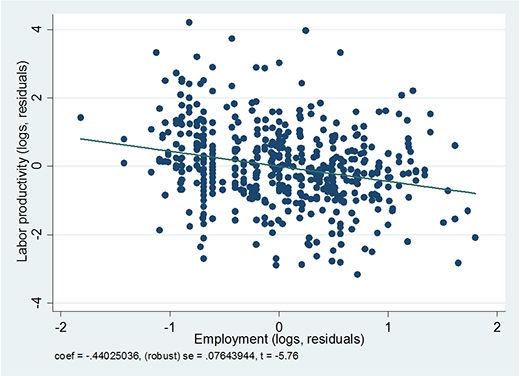
This is the crucial difference between growth and scalable growth.
Scalable growth is built on an organizational foundation that can scale with the growth. It has systems, processes, and standardized practices to resolve the productivity, communication, and management issues that crop up with scaling.
In other words, scalable growth is for organizations that are built to scale.

Why Being ‘Built to Scale’ Matters
Scale is often the foundational principle of most businesses. A software company designs its products to accommodate thousands of concurrent users. A manufacturing business builds plants that can produce at scale. And a retailer’s margins depend on achieving scale to get better deals.
It wouldn’t even be wrong to say that for many businesses, profitability is contingent on achieving scale. Uber, Amazon, Walmart, et al depend on their size to turn small margins into outsized profits.
The agency business is different. Your profitability does not depend on achieving scale. An agency can have the same profit margins with one employee as it does with a 100. Since there is little startup cost, agencies can even be profitable from day one.
Minus this pressure to scale, agencies often fall into the trap of ignoring scalability altogether. They don’t document their processes and neglect systemizing their operations. Often, they over-depend on unpredictable revenue channels, such as referrals.
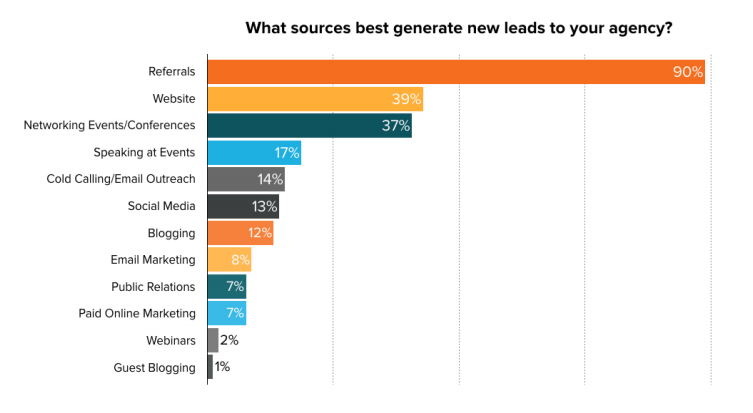
This might be sustainable for a small agency. But as you grow and add more people, the lack of systemization impacts your growth potential. You produce too much data, have too many disparate processes, and little visibility into your agency operations.
Once you move beyond the proverbial “two-pizza team”, communication becomes an issue. Teams start operating in silos, unintentionally locking away knowledge.
When you’re built to scale, you’re able to extract more from your resources. Your processes are clear, deliverables are standardized, and data is defragmented. Your entire agency operates more cohesively and efficiently.
But perhaps the biggest reason to focus on scale is that it lets you focus on being creative and serving clients.
When you have streamlined systems, your resources waste less time dealing with the operational aspects of business. They can focus on delivering results instead of digging for data or hunting for templates.
In the next section, I’ll discuss impediments to scaling and how to resolve them.

What Are the Key Challenges to Scalable Growth?
Robert Sutton, professor of Management Science and Engineer at Stanford notes:
“Scaling challenges nearly always come down to the same problem: the difficulty of spreading something good from those who have it to those that don’t – or at least don’t yet.”
Sutton calls scaling a “problem of more” – more data, more systemization, and more knowledge-sharing.
This problem is inherently circular – hiring more people creates more data, and more data requires more investment in understanding it.
Within an agency setting, this “problem of more” plays out in these issues:
1. Lack of visibility into resource data
Imagine this scenario: after a few months of sustained growth, you decide to hire a second project manager to manage your growing pool of resources.
However, PM #2 uses an entirely different method to track resources than PM #1.
This doesn’t impact your operational efficiency. But when you want to get insight into resource utilization at the end of the quarter, issues crop up: the data is simply too inconsistent to draw any real insight.
This is a frequent problem in agencies that don’t use standardized PM processes. Minor differences in the way managers operate creates big rifts in the accuracy and clarity of resource data.
If performance metrics and tracking methods change from manager to manager, can you say with any certainty how each resource performed?
A smaller agency with a handful of managers can smoothen out these variations. But as your agency scales and takes on even more resources (and managers to manage them), this lack of visibility will limit your growth potential.
2. Data fragmentation
How many systems and tools does your agency use to manage its operations?
For most agencies, the answer would be “many”. They might have one system for accounting and billing. One for managing sales. Another for marketing. And yet another for project management.
When your operations are spread across several systems – most of which don’t talk to each other – the quality of your data invariably suffers. The data is too fragmented; you have to transfer it from one system to another to draw any real insight.
Given the importance of data in decision making for any modern agency, data fragmentation presents a big challenge to scalable growth.
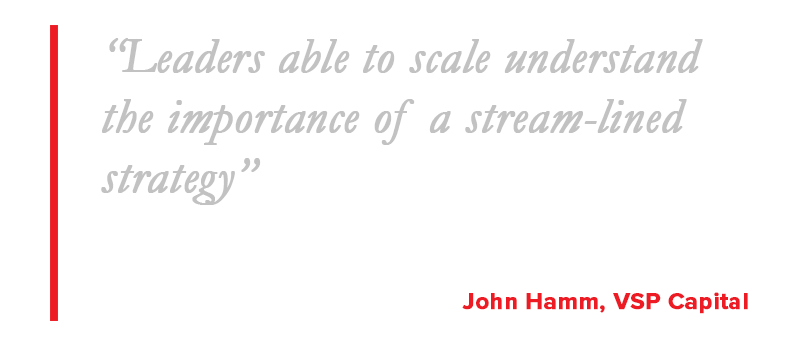
3. Lack of standardization and streamlining
Your agency’s growth depends on your ability to procure, launch, and deliver projects in a streamlined fashion. You can’t create project-related documents and processes from scratch each time. Not only will you waste time, variations across clients will create large inconsistencies.
The solution to this ad-hoc approach? Standardization.
Standardization makes it possible to deploy solutions quickly. You don’t have to start from zero every time. Rather, you can use proven templates and follow fixed processes to deliver results.
This eliminates inconsistencies, reduces deployment time, and makes for more streamlined agency operations – all crucial ingredients for scalable growth.
4. Communication and collaboration issues
There is an astonishing amount of communication that must take place to deliver and bill for even a simple project. Minus a unified platform and standardized communication processes, some information is wont to slip through.
For example, consider all the message that must past back-and-forth for a complex creative deliverable:
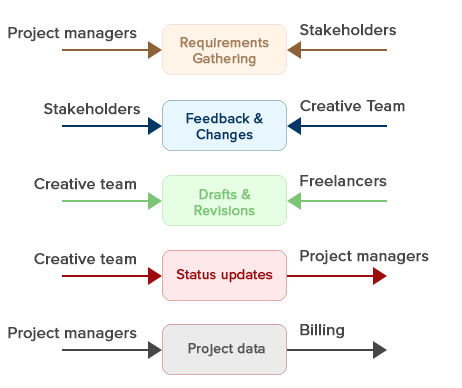
Now extend this to dozens of clients and resources – including third-party vendors and freelancers – and you have a serious challenge to scalable growth.
Meeting these challenges is neither quick nor easy. You often need to re-organize your entire agency and build a foundation for scalability.
But before you can do that, you need to assess your existing scalability potential.

Assess Your Existing Scalability Potential
Before you can restructure your agency for scalable growth, you must assess where you currently stand. You’ll find that some parts of your agency are already primed to scale, while others are more reactive and non-systemic.
Start by segregating your agency operations by their functional roles. Then assess their existing maturity, technological adoption, and clarity of purpose. A scalable operation would be mature, use purpose-driven technology, have a clear focus, and employ formal management structures.
For example, an agency’s market focus can be described as scalable if it has an “ideal customer” profile that it prioritizes in its marketing.
However, if it is entirely reactive, pursuing clients regardless of demographics or firmographics, it would be categorized as unscalable.
The scalability of different agency operations can be assessed as follows:
| Unscalable | Scalable | |
| Agency focus | Reactive, i.e. selling to anyone regardless of client fit. | “Ideal customer”-driven, i.e. selling to clients that meet your ideal profile. |
| Project management | Uses ad-hoc solutions and unspecialized tools (such as Excel) | Uses specific, purpose-driven tools such as specialized project management software |
| Client acquisition | Uses unpredictable revenue streams such as word of mouth | Uses predictable, scalable revenue streams such as inbound, PPC, referral systems, etc. |
| Services | Solutions are created from scratch to address individual customer needs | Solutions are standardized for repeatable across similar client profiles |
| Sales | Salespeople follow their own individual processes | Salespeople follow a standardized process for qualifying, nurturing and closing leads |
| Agency management | Individual tools managing separate agency functions; limited technology adoption; lack of formal managerial roles | Integrated management for different agency functions; extensive technology adoption; formal managerial roles |
The more your operations swing towards the “scalable” side, the easier it will be to scale your agency’s growth.
In the next section, I’ll look over the most important part of this post: structuring your organization to achieve scalable growth.

How to Structure Your Agency for Scalable Growth
Achieving scalable growth isn’t a tactic, trick, or growth hack. It’s not something you can implement over a week.
Rather, it describes a fundamental approach to building agencies.
When you prioritize scalable growth, you also prioritize systems, standardization, and processes. Scalable agencies have formal managerial rigor and entrepreneurial vitality. They can accommodate new clients and resources without a gap in the quality of their output.
So what exactly makes this scalable growth possible?
One Harvard Business Review article describes scalability as dependent on four key elements:
- Hiring functional experts to take the organization to the next level
- Adding management structures to accommodate increased headcount
- Building planning and forecasting capabilities
- Reinforcing cultural values that will sustain the business
I’ll share some practical tips to implement these four elements below.
A note on implementation: Building an agency that can grow at scale is a lengthy process. Any implementation – of strategy or of software – is going to take time. Allow at least a few months for implementation, more for results. See it as an investment – growing fast for years means slowing down for a few weeks.
1. Integrate your systems
If you’re like most agencies, your operations are likely spread all over the place. You’ll have different tools for project management, communication, billing, sales, and account management.
This causes three problems:
- Your data gets fragmented across multiple tools and systems
- You don’t get any visibility into your agency operations as a whole
- Information exists in silos; different departments get locked out of crucial data
Your first step in achieving scalable growth should be to integrate all your systems. Get every part of your operations to talk to each other. Billing shouldn’t have to wait on accounts to get project data. Nor should you struggle to forecast revenue because of limited sales data.
The more cohesive your systems, the more visibility you’ll have into your operations. An all-in-one agency management software such as Workamajig can help in this regard by bringing your entire agency onto the same platform.
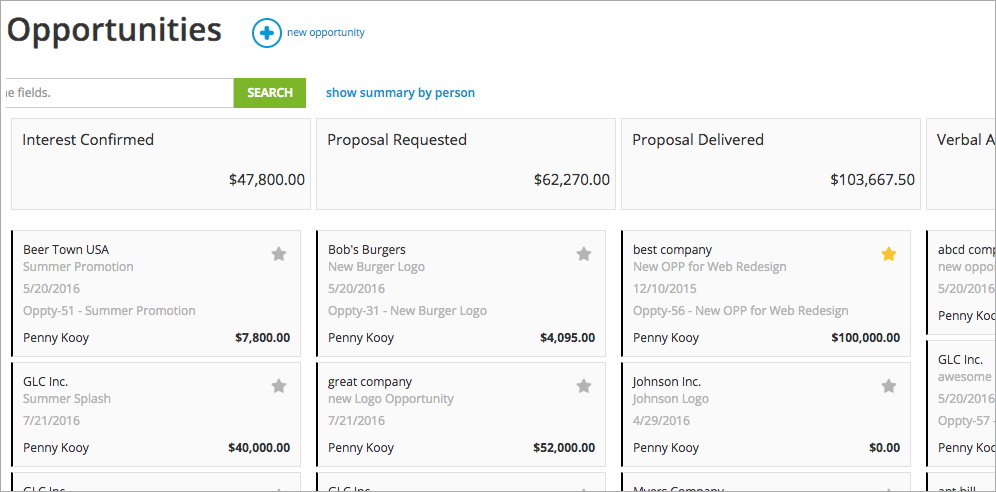
Workamajig integrates all your systems, including sales, so you get unprecedented visibility into your agency’s operations
2. Get better insight into your finances
Have you ever closed a profitable project that ended up turning into a loss after adding all disparate costs?
This is a frequent problem for agencies. Minus cohesive financial data, budget overruns and inside costs can be difficult to spot. This can impact the clarity of your forecasting and chip away at your margins.
For example, to plan your agency’s growth, you need to know which of your clients and project-types are the most profitable. If a particular client/project-type requires too many unbillable hours to serve, you’ll want to avoid them in the future.
Spotting these issues can be difficult unless your sales, project, and billing data are well-integrated. You need to know the dollar impact of inside costs and unbilled hours on your revenue projections. You also need to know whether your revenue forecasts match up with the final billing.
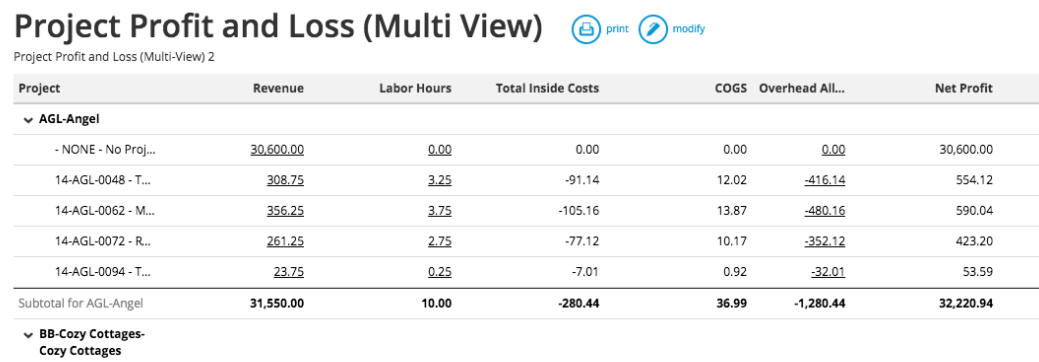
By integrating project and billing data, you get real insight into the “true profitability” of each project
Try implementing an all-in-one system that can bring sales, project, and accounting to the same platform. This will help you get real insight into your “true profit” without significant data wrangling.
3. Build a more scalable lead-gen system
Agencies frequently rely on lead sources that can’t be scaled, such as referrals and word-of-mouth. Without a steady supply of leads, growth inevitably stutters.
The solution is to build a lead-gen system that can scale with your growth. This means moving away from one-off campaigns and towards a more cohesive sales and marketing approach.
Different approaches might work for different agencies. A creative agency, for instance, can’t always rely on search. But for a digital agency, organic traffic can be a valuable lead source.
Andy Crestodina of Orbit Media Studios uses search-focused pages targeting “transactional” phrases.
“All agencies have websites. Most agencies have blogs. But few agencies have search-optimized websites and blogs. For us, the key to growth was to make sure our service pages were search optimized for specific phrases.”
Steve Aguilar of BlueWing, an inbound marketing consultant for agencies, says a more “all-in-one” approach can work better.
“One of the key parts to building a scalable lead-gen system is understanding how different components of digital marketing can play off each other. A lot of times people look at digital marketing as a series of individual channels. (But) in practice all of these channels contribute to each other’s success.”
Essentially, you can’t rely entirely on a single channel – organic, PPC, referrals – since the client journey for agencies is long and complex. You have to adopt an all-in-one approach where each channel is tied to each other.
It’s equally important, Steve says, to “to tie in this digital marketing activity with the sales process.” Your sales process can’t be independent of your marketing. The smaller the disconnect between them, the more streamlined and scalable your lead-gen system.
4. Map your client flow
Client flow analysis is a project management technique frequently used in hospitals to reduce waiting times, reduce bottlenecks, and standardize non-clinical service.
Surprisingly, this concept has equally strong application in scaling an agency.
Within an agency setting, client flow describes the path clients take from the moment they enter the pipeline to the final post-delivery communication. It describes every single touch point between the client and your agency.
The more visibility you have into the client flow, the easier it will be to standardize processes.
For example, you might identify three client acquisition paths – via referrals, inbound, and outbound sales. Post-acquisition, you would want to onboard each of these clients in a different manner. By mapping out the client flow, you can create separate templates for a smoother onboarding process.
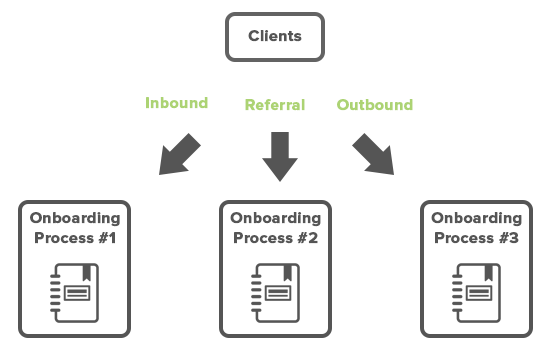
Most agencies have their sales and project management processes already mapped out. But this exercise will help you connect these processes with each other and the rest of your operations (such as billing).
5. Document your processes
Agencies can be strangely resistant to documenting their processes. There is a mistaken belief that being process-focused is antithetical to the entrepreneurial, creative nature of agencies.
As Ron Carucci says:
“Of all the words that make entrepreneurial leaders shudder, few do it more than ‘process’ They associate the word with corporate bureaucracy. They fear that standardizing approaches to work will neuter entrepreneurial freedom and stunt creativity.”
This fear is usually unfounded. Process doesn’t tie you down; it liberates you to focus on delivering results. If you have documented processes, you spend less time asking “what next?”, and more time on creating solutions.
Use the client flow map as the starting point in your process documentation. Get every department involved to document their workflows at every stage of the project life cycle. The more you understand your processes, the easier it will be to standardize them.
6. Assess the maturity of your processes
Michael Hammer, one of the founders of the management theory of business process reengineering (BPR), once wrote:
“Form influences function — process design determines performance.”
That is, the clarity of your processes influences the quality of your performance.
Once you’ve documented your processes, it is time to assess their maturity and competence. The more mature and well-integrated the processes, the easier it will be to scale them.
Hammer offers a framework for process analysis that segregates an organization’s processes into five categories – Design, Performers, Owner, Infrastructure, and Metrics. These are further divided into categories such as Purpose, Context, Documentation, etc.
You score your processes as P-1, P-2, P-3, and P-4 based on their maturity.
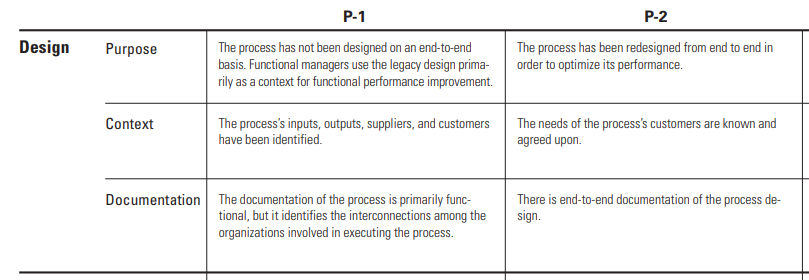
You can grab a PDF detailing this assessment process here.
Once you’ve assessed the maturity of your processes, you can standardize them.
7. Redesign processes to remove inefficiencies
Poorly optimized and immature processes often have inefficiencies that cause delays and add to your costs. You might be asking for data that you don’t really need or involving intermediaries who don’t bring any real value to the table.
Analyze the processes you identified above and look for any obvious inefficiencies. These often appear in the form of:
- Excessive data/requirements gathering
- Overproduction or habitual scope creep
- Limited data sharing and visibility across involved stakeholders
- Communication inefficiencies (though it’s better to err on the side of over-communication)
- Vendor inefficiencies
Look out for inefficiencies caused due to over-optimization as well. You can very well streamline a process so much that you don’t have enough data to act on in case of an emergency.
Once you’ve identified these inefficiencies, redesign your processes from scratch. This shouldn’t be a superficial exercise. If the structures underlying the processes remain the same, the performance issues will creep back in.
For example, you might design communication processes to remove all inefficiencies. But if there is no organization-wide focus on clear communication, the processes will falter.
Michael Hammer, in the article I shared earlier, asserted that redesigning processes – as opposed to modifying them – is the:
“…only way to improve their performance dramatically. Doing so eliminates many of the nonvalue-adding activities that are the source of costs, errors, and delays.”
That is, you can’t superimpose modified processes on existing structures; you have to modify the underlying structures as well.
8. Remove cultural barriers to scaling
Scaling isn’t just a matter of processes and systems. In many agencies, there are also cultural barriers that hamper scalable growth. Organizations with an entrepreneurial bent can be resistant to growing beyond a certain size.
As Jay Chiat of Chiat/Day once asked of his own agency:

This resistance comes from the fear that expanding might impact an agency’s culture and creative output. While it is true that culture can be difficult to scale, it isn’t impossible. Reassuring your people that you can grow without hurting your core beliefs, you can get them to buy into your scaling efforts.
Here are some steps you can take to scale your culture:
- Purpose: Define the ‘why’ of your agency’s existence – your reason for existing. Scaling is easier when everyone can rally around the same mission.
- Define your common language: Every agency has its own “language” – insider jokes, shared slang, and ideas that only agency veterans will understand. If you can define this common language, you can also spread it to new hires and get them involved in the agency’s culture.
- Embrace your cultural ambassadors: Successful agencies often have informal cultural ambassadors – frontline leaders who, unknowingly or unknowingly, champion the agency’s culture, ideas, and values. Embrace these people and formalize their roles to ensure that your values don’t get lost as you grow.
And as always, lead by example. Your people will believe whatever cultural principles you espouse and exemplify.
There are other elements of scaling up growth – streamlining communication, formalizing managerial roles, etc. – but the eight tips I shared above should be your top priority.
Over to You
Scalable growth is an ambitious goal. It requires standardizing your processes, streamlining your operations, and even restructuring your entire agency. It’s not a “growth hack” you can implement over a weekend; it demands commitment and investment.
The rewards, of course, are worth it. An agency structured for scalable growth will find it easier to do its best work, get better clients, and be more profitable.
Business & Finance Articles on Business 2 Community
(114)
Report Post





